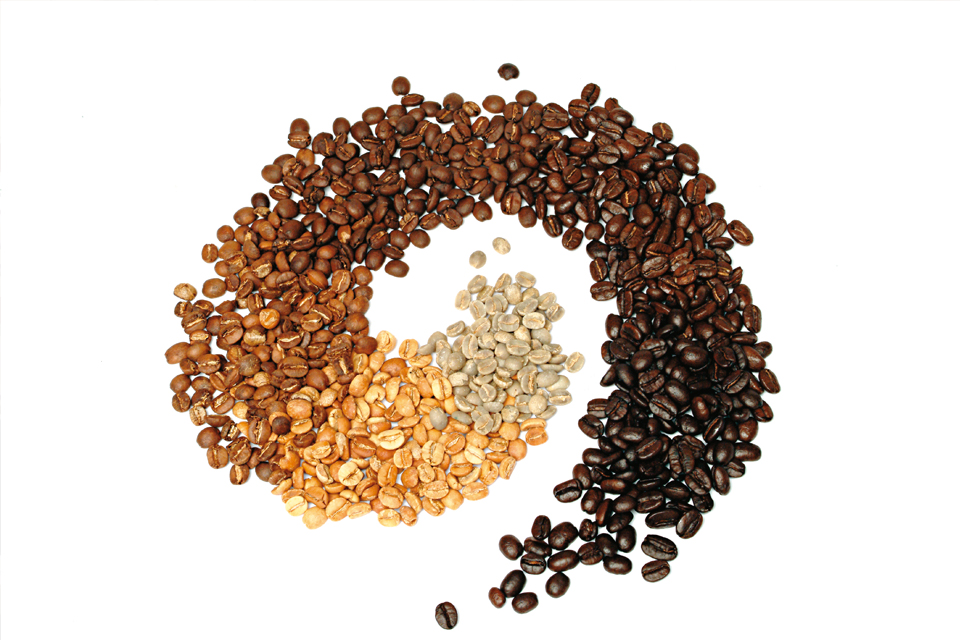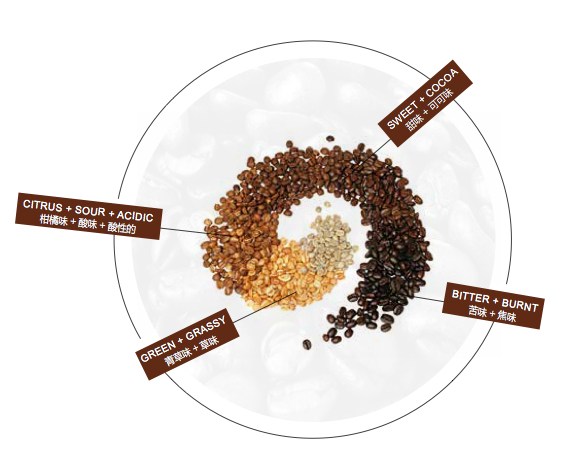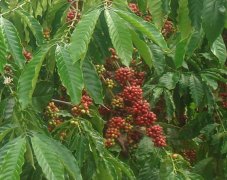Italian blending Coffee Flavor combination how to find the proportion that best meets your expectations
Sometimes, you will see a lot of marks on the coffee bean cup score table that have not been paid attention to before, such as almond pie, dried currants, green peaches or cream. So, which of these unique flavors are born with coffee beans and which are roasted?
Raw coffee beans tend to have the "farm aroma" of grass or hay, but if they are not properly preserved during storage and transportation, they will smell moldy, dusty, and even wet cat food. sometimes you can smell a fermented smell similar to a long-placed cork of red wine. When you open the sack of raw beans in beautiful weather, the smell of sweet and ripe red fruit will come to your nostrils. As a digression, I am sure that color can be perceived through the sense of smell. If you don't believe it, you can make a sensory Mini Game, cover your eyes, open a big bag of lollipops, and I bet you can tell the colors of most lollipops.

Most of the bad odors mentioned above, such as moldy or dusty coffee beans, are produced in the process of planting, storage, packaging and transportation, and most of these smells are still present after baking. Only in the case of extremely deep baking can these flavors be masked or changed.
Other flavors and aromas of coffee beans are innate, and we assume that all coffee fruits are picked at full maturity, then the aroma of coffee beans will be determined by the planting variety, growth altitude, soil conditions and ecological environment.
When a coffee roaster wants to create a new blend of coffee, each bean will be seen as an "ingredient", just as a chef chooses seasoning on the table. The baker is familiar with the characteristics of each bean and knows exactly how they will affect the flavor of the new coffee mix. Sometimes, the most significant contribution of a single bean to the blending of coffee is not the taste or aroma, but the tactile feel it brings, such as mellow thickness and taste. In different kinds of blended coffee, the main role of each single bean will be different.
Continue to use chefs to make examples of cuisine, the choice of different degrees of cooking will also affect the flavor of ingredients. For example, after different cooking time and different heat treatment, onions will show the taste of spicy, slightly spicy, bitter, sweet, caramel, iron plate, burnt and charred. We call it the "flavor wheel" of onions. By the same token, it is impossible for us to smell all the inherent flavors of raw coffee beans directly. Different flavors and aromas are reflected in different stages of coffee roasting, but disappear with the deepening of roasting.

So, what flavor can the baker present with raw beans? I am used to dividing it into eight stages, of course, there are more states in the middle of each level, and the flavor presented at this time will have all the characteristics of both stages. But the most basic flavor is shown in the picture above.
In the first half of the figure, the flavor is similar to that of raw beans, and beans that have not been baked or baked for too short will show the flavor of hay, wheat, straw or harvested straw. Next, we will be able to taste citrus acid similar to lemon. As the baking time lengthens, the soft sour taste will be presented, similar to the Australian green apple flavor. After that, the sour taste will become brighter, showing the sour taste of red wine.
The second half of the figure is the coffee flavor that most people prefer. As the roasting degree of coffee beans continues to deepen and enter moderate baking, sweetness will replace sour taste to become the main flavor. When the coffee bean turns brown, it will show a series of caramel flavor, and then it will slowly become cocoa, which is also the critical point for the coffee to show the best mellow thickness. As the baking goes further, the bitterness will mask the sweetness and become more obvious, with a flavor similar to dark chocolate with 80% cocoa content. If the coffee beans are roasted for too long, we will lose all the positive flavor, and we will experience the taste and smell of barbecue, charcoal, smoking and so on.
It is difficult for baristas to add apple or creamy aroma to their blended coffee. What they can do is to increase the mellow thickness, highlight sweetness and other flavors (e.g. cream). Then blend in a slight sour taste and add an aftertaste (for example, the sour taste of green apples).
When you create a brand new coffee mix, it is extremely important to pass on your ideas and feedback to the baker in a timely manner. Only when you can express your ideas in detail and know exactly which flavor you want to present at different stages such as coffee entrance, aftertaste, etc., will your baker find the proportion that best meets your expectations.
Important Notice :
前街咖啡 FrontStreet Coffee has moved to new addredd:
FrontStreet Coffee Address: 315,Donghua East Road,GuangZhou
Tel:020 38364473
- Prev

The price of coffee beans how is the price of coffee beans so expensive?
It is often asked how the price of a certain type of coffee beans is so expensive. In fact, the price of coffee beans still involves many factors. Factors that affect the price of coffee beans include climate, yield, crop diseases and stocks. Coffee bean futures have always been one of the most speculative commodities in the world. The price of coffee beans can also be judged simply by their appearance, delicious coffee, from its
- Next

The difference between individual Coffee and mixed Coffee basic knowledge of Coffee
The difference between individual items and matching is like the difference between monochrome and colorful oil paintings. Single drink also has a pleasant taste, but beauty is beautiful, but the final monotonous taste, lack of thick. On the other hand, the match is like a very full oil painting, which is composed of multiple tones and is a cup of coffee that makes people feel like a story. I'm not sure if this is true insight or nonsense, so this article is
Related
- Detailed explanation of Jadeite planting Land in Panamanian Jadeite Manor introduction to the grading system of Jadeite competitive bidding, Red bid, Green bid and Rose Summer
- Story of Coffee planting in Brenka region of Costa Rica Stonehenge Manor anaerobic heavy honey treatment of flavor mouth
- What's on the barrel of Blue Mountain Coffee beans?
- Can American coffee also pull flowers? How to use hot American style to pull out a good-looking pattern?
- Can you make a cold extract with coffee beans? What is the right proportion for cold-extracted coffee formula?
- Indonesian PWN Gold Mandrine Coffee Origin Features Flavor How to Chong? Mandolin coffee is American.
- A brief introduction to the flavor characteristics of Brazilian yellow bourbon coffee beans
- What is the effect of different water quality on the flavor of cold-extracted coffee? What kind of water is best for brewing coffee?
- Why do you think of Rose Summer whenever you mention Panamanian coffee?
- Introduction to the characteristics of authentic blue mountain coffee bean producing areas? What is the CIB Coffee Authority in Jamaica?

